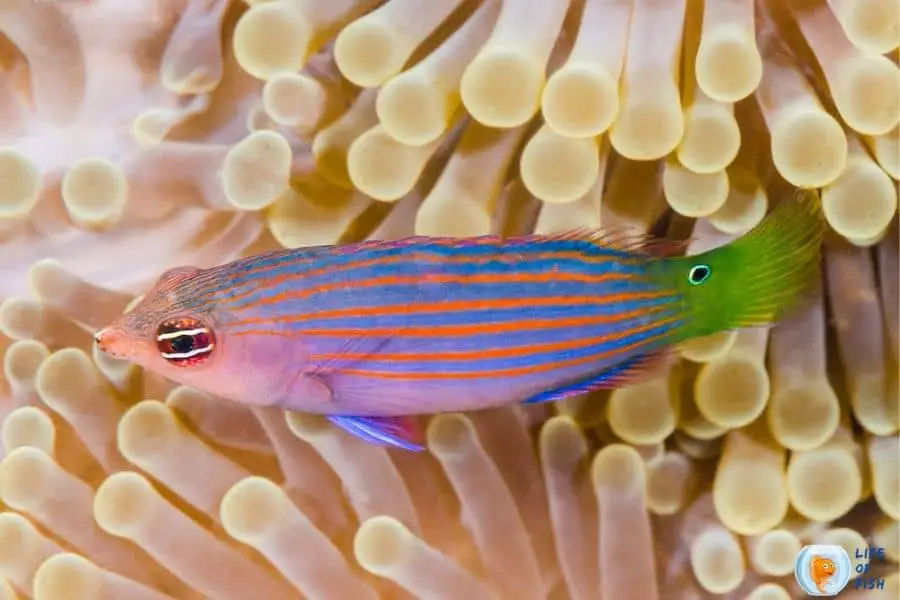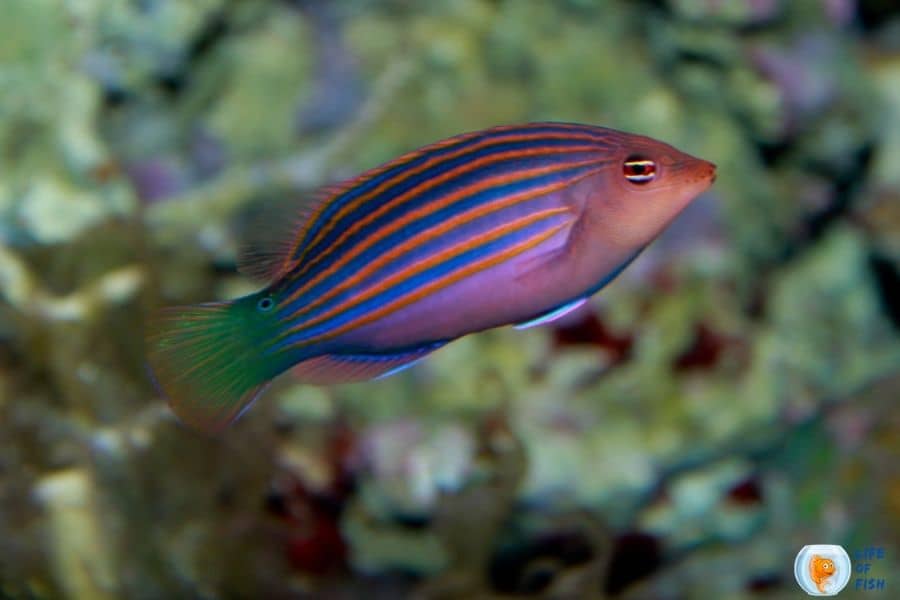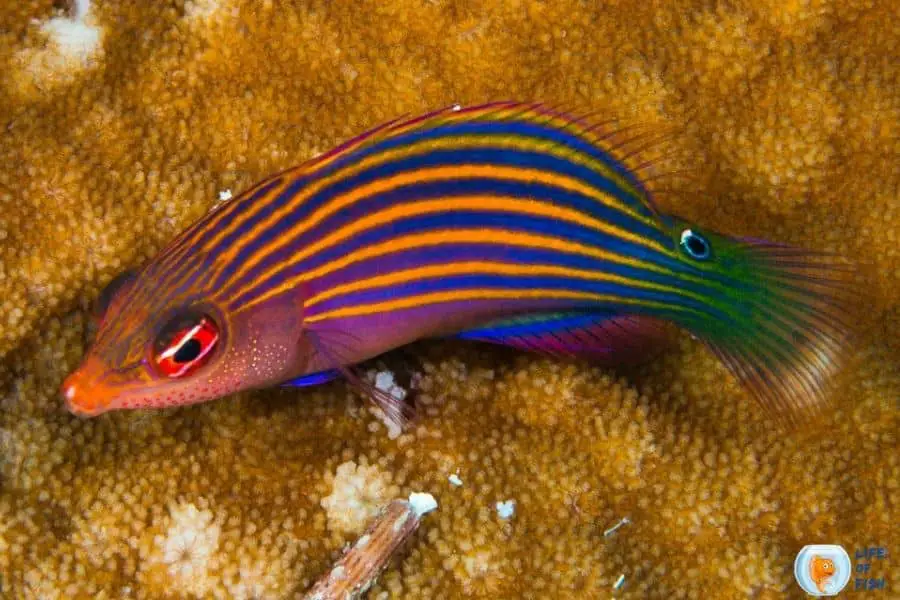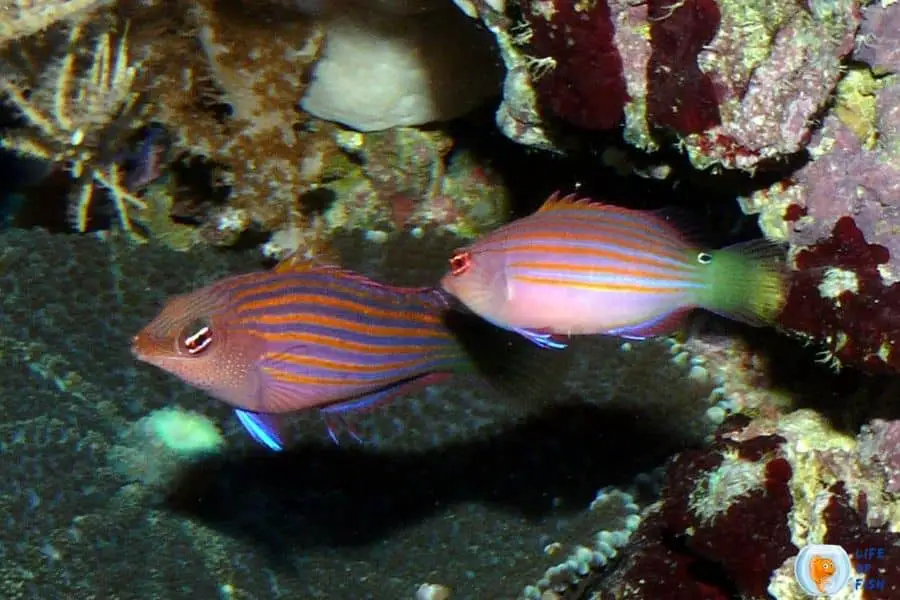If you’re in the market for a colorful and active fish to add to your aquarium, the Sixline Wrasse may be the perfect choice for you. These vibrant fish are known for their striking appearance and energetic behavior, making them a popular choice among hobbyists.
But before bringing a Sixline Wrasse home, it’s important to understand their care requirements to ensure that they thrive in their new environment. In this blog post, we’ll explore everything you need to know about caring for them, including their ideal tank setup, feeding habits, and common health issues. So, let’s dive in and learn more about these fascinating fish!

More about them
Jump To
They have a false eyespot on their dorsal tail peduncle. It is used to trick predators to attack the back end of the fish, allowing it to escape if attacked.
They are marine reef fishes that occur in many places in Indo-Pacific marine regions where there are coral reefs in shallow, clear and warm water. They spread from the eastern coast of Africa where it is found from the Red Sea to South Africa across the Indian Ocean and into the Western Pacific Ocean where its range extends north to Japan, south to northern Australia, and east as far as Tuamotu.
The Sixline wrasse belongs to the family of Labridae. There are seven species under the genus Pseudocheilinus. The scientific name of Sixline wrasse is Pseudocheilinus hexataenia.
Looking for tips on how to identify different species of wrasse fish? Our guide has all the information you need!” – wrasse fish
How big do Sixline Wrasse get?
They are quite small fish. The maximum length reported for this species is 10 centimeters (3.9 in). However, normally they reach 3 inches (8 cm) only in captivity.
Are they aggressive?
Yes, they are fairly aggressive fish, especially towards some invertebrates and some fish species too. Therefore, careful consideration is needed before adding them to a community tank.
Sixline Wrasse behavior
They are found in clear coastal waters where the depth is around 20 meters (66ft). They spend their days foraging in the cracks and crevices of reefs, looking for small prey animals to eat. These fish are quite secretive and shy species and are normally encountered in small, loose groups.
They are diurnal species and during the daytime, they swim among branches of coral for their protection. During the nighttime, they create a mucus cocoon, like many other members of the wrasse family. The mucus cocoon helps them to protect from nocturnal predators by masking the scent of the sleeping fish. They are very active fish and always swim around the coral and the other decorations for looking for food.
However, they are not reluctant to harm other fish especially smaller and slower fish when they are not looking for food. Sometimes they are peaceful and at one night they can be very aggressive without no significant reason. Many aquarists give up keeping Six wrasses because of this unpredictable behavior.
They are acting as cleaner fish. They remove parasites such as copepods and isopods from other fishes and help to keep the aquarium clean. During their spawning period, the paired adults undertake a very quick dash towards the surface to spawn. The speed of this quick dash reduces the risk of predation by other fish. They show this behavior just before the sunset.
How long do Sixline Wrasse live?
Their lifespan is four to six years in captivity. However, some aquarists report that they can live 10 years or more in captivity under proper care. Generally, they are considered hardy fish once they have been established in a reef aquarium.

One look Care guide
| Scientific name | Pseudocheilinus hexataenia |
| Common name | Six Stripe Wrasse Sixline Wrasse |
| Care level | Easy |
| Native to | The Red Sea Indo-Pacific Western Indian Ocean |
| Type | Marine water |
| Color | Pink, blue fish with orange strips |
| Tank size | 40 gallons |
| Prefered temperature | 70°F – 80°F (21°C – 27°C). |
| Other water parameters (ammonia ,ect) | pH : 8.1 – 8.4 S.G : 1.020 – 1.025 Hardness : dKH: 8 – 12° |
| Prefered salinity | 1.025 or 35 PPT |
| Size | 3 inches |
| Growth rate | Moderate |
| Temperament | Semi -aggressive |
| Recommended tank mates | Angle fish Clownfish Tangs |
| Prefered food | Mysis brine shrimp other carnivorous frozen diets |
| Feeding frequency | 2 to 3 times per day |
| breeding | Egg layer, hard to breed in aquariums |
Sixline Wrasse care
Fish size
They are quite small fish and they reach 3 inches (8cm) in length after they become maturity.
tank size
As they are quite small fish the tank size of 30 gallons is enough. This is the minimum tank size for one wrasse and if you need to keep more Sixline wrasses need to have a larger tank. However, according to recent research at least 40 gallons tanks will be needed regardless of their small size
How many of them should be kept together?
Sixline wrasses are semi-aggressive species and tend to attack the same species when they are in limited spaces like aquariums. Though they form small loose groups in their natural environment, in an aquarium putting two Sixline wrasses may arise many problems due to their aggression. Therefore, aquarists advice not to put two wrasses in the same tank if you don’t have an absolutely large tank. In such a situation, a tank not less than 100 gallons is recommended.
Anyway, if you can choose one male and one female and put them in one tank, then they do well in the same aquarium. However, keep in mind to keep them in a larger tank as they need larger space to swim.
Tank setup
Though many aquarists suggest that a small tank is enough for the sixline wrasses due to their small size, some have generally agreed that they need a lot more space than was originally believed.
They claim that small spaces increase their stress level and suggest having at least 40 gallons tank with intricate rockwork should be enough space for your Six-line wrasse to freely roam.Since they love to roam near corals and rocks when they are in the wild, it is necessary to put live rocks into the aquarium.
Providing a sand bed is also important as they usually hide in the sand when they are stressed as many other wrasse species do.
However, showing sleeping on the sand bed is a sign that something is wrong in the aquarium. The Six-line wrasses are hardy fish and thrive well with sudden changes once they are established. Therefore, they do not need further special requirements or care like other aquarium fish. However, proper care is needed until they are established.
Anyway, like many members of the wrasse family, they are incredible jumpers, and therefore tight – fitting canopy is essential.
Keep in mind they are aerodynamic and can escape out of small openings in the top of the aquarium. It is better to put a mesh net to prevent your fish from jumping if you have a rimless aquarium. If you are plan to put them in a community tank, try to put the Sixline wrasses at last to secure the peace of the aquarium.
Water quality condition
Sixline wrasses are marine fish and need standard saltwater parameters. The pH of the water should be at 8.1 – 8.4 while the hardness at dKH: 8 – 12°. The specific gravity of the water should be at 1.020 – 1.025. They are tropical fish hence need a temperature around 70°F – 80°F (21°C – 27°C). Aquarists advise using a good filter to keep the water parameters at their maximum level.


Sixline Wrasse breeding
Male or female identification
They do not show sexual dimorphism hence cannot identify them by just looking at them. However, owners noticed that males get more vibrant colors than females just prior to or during the spawning. Anyway, it is not a distinguishable factor hence it can be concluded that male and female identification by external appearance is not possible.
Like many members of the wrasse family, they show Hermaphroditism. It means the fish who are born as females can be turned into males depending on internal and external factors. However, this is not likely to happen in closed systems like aquariums.
Sixline Wrasse breeding
Although spawning is reported in aquariums, many aquarists claim that it is almost impossible to raise them in aquariums. Another problem is it is hard or nearly impossible to determine the gender of the wrasse prior to purchase unless you have a pair that have already mated.
The Sixline wrasses are broadcast spawners. They spray their eggs and sperms all over their area rather than put them in a cave or a clutch. Therefore, it is hard to identify their spawning, hence the eggs and sperms get end with the filtration system. In wild, the eggs get fertilized with the help of water currents.
How to identify pregnant Sixline wrasse?
There are some records that they getting pregnant in aquariums. The pregnant female can be identified by their protruding belly.

Feeding behavior of Sixline Wrasse
What do they eat?
The Sixline wrasses are carnivorous fish that eat mostly animal proteins. In wild, they fed on small invertebrates such as snails, clams, flatworms, and crustaceans.
In aquariums, they need to feed with a carnivorous pelleted diet and supplement with meaty treats such as Mysis, brine shrimp, and other frozen diets. They are fine with many meals available and it is not hard to feed them. Further, as they are natural “cleaners” they will eat the snails and other invertebrates who make trouble to your aquarium.
How often should you feed
Being tropical small fish, they need to feed at least twice a day. Sometimes they need to feed three times per day too. Try to feed them with small meals 2-3 times per day. Keep in mind not to feed them with large meals as they eat a small amount the rest of the food ruins the water quality of the aquarium.
When should you feed (time of the day)
They are diurnal fish and they need to be fed during the daytime
How long they can go without food
They can’t go long without food. They eat small amounts and it digests in a small time. Therefore, they will get hungry frequently
What fish can live with Sixline Wrasse?
The sixline wrasses do not nip at corals and they are typically reef safe. They are particularly, aggressive towards other fish, particularly other smaller, peaceful wrasses. They are not compatible with shy fish like marine betta, fairy wrasses, firefish, Royal gramma fish, or leopard wrasses.
Also, slow swimmers like mandarin gobies, seahorses, and pipefish are not a good match because the aggressive nature of Sixline wrasses makes them starve. If you plan to put a sixline wrasse into the tank, wait until all the other fish species are introduced to the tank and give them enough time to settle in. They will not harm other fishes if you introduce them at last.
Their aggression may be due to apparent over food, space, or other resources. Therefore keep in mind to give them enough space to swim and not to add much fish which does not match the tank size. Also when you feed them spread food around the aquarium to reduce competition for food. However, it is advised to keep only one Sixline wrasse unless you are not intended to breed them.
Although other types of wrasses are not a good match for them, they do well with larger,semi-aggressive wrasse species. Banana wrasse and the dragon wrasse are some examples. However, since they are large and need considerable space be careful about the tank size.
Further, It is not good to keep grammas, pseudochromis with Sixline wrasses because they may harass the above species. Most of the times Clownfish, Tangs and angle fish do well with these semi-aggressive species.
Related questions
Is Sixline Wrasse aggressive?
They are semi-aggressive species. They are aggressive with the same species and other wrasse species too.
How big do Sixline Wrasse get?
They are small species and grow up to 3 inches in aquariums
Can Sixline Wrasse live in a pond?
Although they are hardy fish and can settle in most environmental conditions, it is not good to keep them in a pond. Because they are good jumpers and will jump away from the pond.
Read Next : Cleaner Wrasse | Definitive Care Guide | Reef Safe Aquarium Fish Yellowfin Flasher Wrasse | A Fish Like No One Else |
